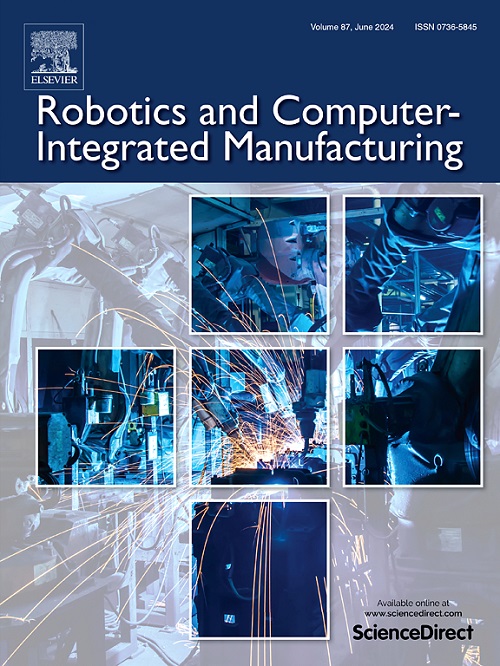线激光传感器重载工业机器人手眼系统测量误差建模与补偿
IF 11.4
1区 计算机科学
Q1 COMPUTER SCIENCE, INTERDISCIPLINARY APPLICATIONS
引用次数: 0
摘要
在重载机器人携带直线激光传感器的连续扫描过程中,测量精度容易受到几何误差和关节变形的影响。传统的弹性几何误差补偿方法往往严重依赖于外部测量系统的校准精度,这限制了其在现场应用中的灵活性和精度。为了解决这一限制,本研究提出了多集内聚校准(MSCC)方法,该方法在参数识别之前不需要高精度的外部系统校准。MSCC将机器人几何误差、柔度误差和外部参数误差整合到一个统一的误差模型中,利用多组态测量数据协同求解,从而增强了标定系统的稳定性和适应性。此外,为了解决高维强耦合参数辨识问题,引入了一种三阶段混合优化算法——探索-退火- lm (EALM)算法,提高了参数估计过程中的收敛性和全局搜索能力。结果表明,在大型结构件在线测量应用中,该方法的平均测量误差为0.0545 mm,最大误差为0.1296 mm,与未补偿情况相比,分别减小了84.36%和78.31%。本文章由计算机程序翻译,如有差异,请以英文原文为准。
Modeling and compensation of measurement errors in hand-eye system for heavy-load industrial robots with line laser sensor
During the continuous scanning process in which a heavy-load robot carries a line laser sensor, measurement accuracy is susceptible to the influence of both geometric errors and joint deformations. Traditional elastogeometric error compensation methods often rely heavily on the calibration accuracy of external measurement systems, which limits their flexibility and precision in on-site applications. To address this limitation, this study proposed Multi-Set Cohesive Calibration (MSCC), a method that eliminates the need for high-precision external system calibration before parameter identification. The MSCC integrated robot geometric errors, compliance errors, and extrinsic parameter errors into a unified error model, solving them collaboratively using multi-configuration measurement data, thereby enhancing the stability and adaptability of the calibration system. Furthermore, to address the high-dimensional and strongly coupled parameter identification problem, a three-stage hybrid optimization algorithm called the Exploration-Annealing-LM (EALM) algorithm was introduced to improve the convergence and global search capability during parameter estimation. The results demonstrated that, in online measurement applications for large structural components, the proposed method achieves an average measurement error of 0.0545 mm and a maximum error of 0.1296 mm, representing reductions of 84.36% and 78.31%, respectively, compared to the uncompensated case.
求助全文
通过发布文献求助,成功后即可免费获取论文全文。
去求助
来源期刊
CiteScore
24.10
自引率
13.50%
发文量
160
审稿时长
50 days
期刊介绍:
The journal, Robotics and Computer-Integrated Manufacturing, focuses on sharing research applications that contribute to the development of new or enhanced robotics, manufacturing technologies, and innovative manufacturing strategies that are relevant to industry. Papers that combine theory and experimental validation are preferred, while review papers on current robotics and manufacturing issues are also considered. However, papers on traditional machining processes, modeling and simulation, supply chain management, and resource optimization are generally not within the scope of the journal, as there are more appropriate journals for these topics. Similarly, papers that are overly theoretical or mathematical will be directed to other suitable journals. The journal welcomes original papers in areas such as industrial robotics, human-robot collaboration in manufacturing, cloud-based manufacturing, cyber-physical production systems, big data analytics in manufacturing, smart mechatronics, machine learning, adaptive and sustainable manufacturing, and other fields involving unique manufacturing technologies.

 求助内容:
求助内容: 应助结果提醒方式:
应助结果提醒方式:


